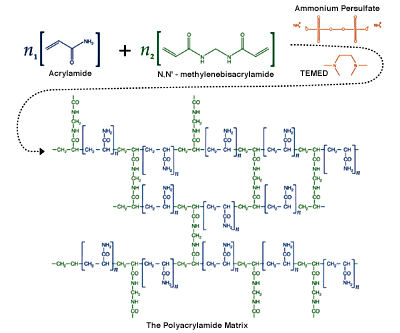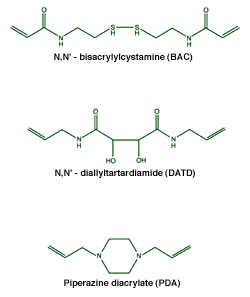The Polyacrylamide Matrix
Polyacrylamide gels are formed by the polymerization of acrylamide in an aqueous solution in the presence of small amounts of a bifunctional crosslinker. The crosslinker is usually methylenebisacrylamide (bis, or MBA).

The polymerization of a polyacrylamide matrix with methylenebisacrylamide cross-linking.
Polyacrylamide gels are formed by the polymerization of acrylamide in aqueous solution in the presence of small amounts of a bifunctional crosslinker. The crosslinker is usually methylene:bisacrylamide (bis, or MBA). The copolymerization of acrylamide with methylenebisacrylamide produces a mesh-like network in three dimensions, consisting of acrylamide chains with interconnections formed from the methylenebisacrylamide. A variety of crosslinkers are available in addition to bis. These include piperazine diacrylate (PDA), N,N'-bisacrylylcystamine (BAC), and N,N'-diallyltartardiamide (DATD). PDA is used to reduce silver stain backgrounds in SDS-PAGE gels. BAC and DATD are both disruptable cross-linkers that enable gels to be solubilized.

BAC, DATD, and Piperazine diacrylate are sometimes used as cross-linkers in polyacrylamide gels to vary the physical or chemical properties of the gel.
For discussions of the composition of polyacrylamide gels, a standard nomenclature has been widely adopted. In this nomenclature, T represents the total percentage concentration (w/v) of monomer (acrylamide plus crosslinker) in the gel. The term C refers to the percentage of the total monomer represented by the crosslinker. For example, an 8%, 19:1 (acrylamide/bisacrylamide) gel would have a T value of 8% and a C value of 5%.
Upon the introduction of the catalyst, the polymerization of acrylamide and methylene bisacrylamide proceeds via a free-radical mechanism. The most common system of catalytic initiation involves the production of free oxygen radicals by ammonium persulfate in the presence of the tertiary aliphatic amine N,N,N',N'-tetramethylethylenediamine (TEMED). Another catalytic system involves the generation of free radicals via a photochemical process using a very small amount of riboflavin in the presence of TEMED. In both catalytic systems, the presence of excess oxygen will inhibit the polymerization elongation process and can lead to a shorter average chain length. For this reason, if the casting solution has been excessively agitated, deaeration under vacuum with a magnetic stirrer is suggested prior to the addition of initiators.
For certain applications, polyacrylamide has definite advantages compared to agarose. In an agarose gel, the pore size is large, so molecular sieving, i.e. separation by size, will not occur for smaller DNA fragments and most proteins. Additionally, by altering the total concentration of monomer in the gel and the ratio of acrylamide to bis, the pore size with a polyacrylamide gel can be altered in a reproducible manner. The small and reproducible pore size in polyacrylamide gels results in superior resolution: a 0.1% difference in size (1 base difference in a 1kb molecule) can be detected. Also, because acrylamide and bis are synthetic chemicals, there are virtually no batch-to-batch differences (It should be mentioned that batch-to-batch differences with agarose are overcome with the highest quality agaroses, such as National Diagnostics' AquaPor agaroses).
Control of the pore size of a polyacrylamide gel is accomplished by changing the T and C values. With increasing T, the pore size decreases in a nearly linear relationship. Higher percentage gels (higher T), with smaller pores, are used to separate smaller molecules. The relationship of C to pore size is more complex. Generally, the minimum pore size occurs when C is about 5% (a 19:1 gel). Decreasing C results in a more open pore structure because there are fewer crosslinker molecules. Increasing C beyond 5% also increases the pore size. This appears to be because of the nonhomogeneous bundling of strands in the gel.
Researchers have settled on C values of 5.0% (19:1 acrylamide/bis) for most forms of denaturing DNA and RNA electrophoresis and 3.3% (29:1) for most native DNA and RNA gels. For SDS-PAGE electrophoresis of proteins, the standard C value that has been adopted is 2.6% (37.5:1). The table below gives recommended acrylamide/bis ratios and gel percentages for different molecular size ranges.
| Acrylamide:MBA Ratio |
Gel % | Native DNA/RNA (bp) |
Denatured DNA/RNA (bp) |
Protein (kp) |
|---|---|---|---|---|
| 19:1 | 4 | 100-1500 | 70-500 | >100-200 |
| " | 6 | 60-600 | 40-400 | 40-150 |
| " | 8 | 40-500 | 20-200 | 20-100 |
| " | 10 | 30-300 | 15-150 | 15-70 |
| " | 12 | 20-150 | 10-100 | 8-60 |
| 29:1 | 5 | 200-2000 | 70-800 | >150 |
| " | 6 | 80-800 | 50-500 | 50-200 |
| " | 8 | 60-400 | 30-300 | 30-125 |
| " | 10 | 50-300 | 20-200 | 20-100 |
| " | 12 | 40-200 | 15-125 | 10-70 |
| " | 20 | <40 | <40 | ><30 |
| 37.5:1 | 6 | -- | -- | 60-200 |
| " | 8 | -- | -- | 50-150 |
| " | 10 | >-- | -- | 25-100 |
| " | 12 | -- | -- | 15-80 |
NEXT TOPIC: The Agarose Matrix
